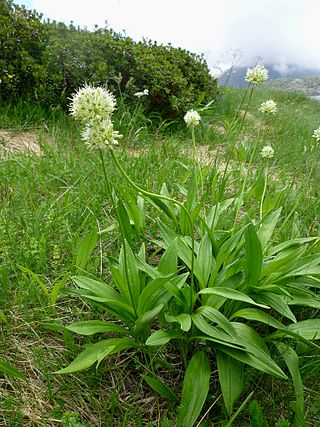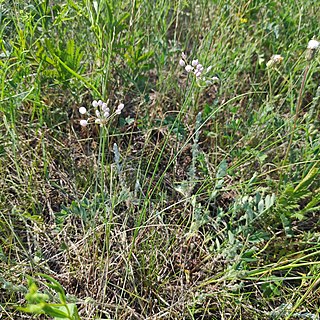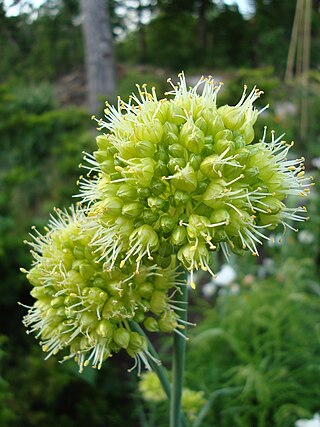
Allium monanthum, the Korean wild chive, is a spring vegetable with minuscule bulbous roots that have a mild onion flavor and found in the woodlands of Korea, Japan, northeastern Russia (Primorye), and northeastern China.

Allium victorialis, commonly known as victory onion, Alpine leek, and Alpine broad-leaf allium is a broad-leaved Eurasian species of wild onion. It is a perennial of the Amaryllis family that occurs widely in mountainous regions of Europe and parts of Asia.

Allium anisopodium, also called thread-leaf chive, is a species of plant native to Siberia, the Russian Far East, Korea, Kazakhstan, Mongolia, and northern China.
Allium eduardii is a plant species native to Russia, Mongolia, and northern China.

Allium ledebourianum is an Asian species of wild onion native to central and northeastern Asia: Kazakhstan, Mongolia, Russia, and China. It occurs at elevations up to 1800 m elevation.
Allium leucocephalum is an Asian species native to Buryatiya, Zabaykalsky Krai, Mongolia, Inner Mongolia, Gansu, and Heilongjiang.
Allium longistylum, also called riverside chive, is a species of wild onion native to Korea and northern China. It grows at elevations of 1500–3000 m.

Allium macrostemon, Chinese garlic, Japanese garlic or long-stamen onion, is a species of wild onion widespread across much of East Asia. It is known from many parts of China, as well as Japan, Korea, Mongolia, Tibet and Primorye. It has been collected from elevations ranging from sea level to 3000 m.

Allium mongolicum is an Asian species of wild onion native to Mongolia, Inner Mongolia, Tuva, Kazakhstan, and parts of China.
Allium neriniflorum is a species of wild onion native to Mongolia, the Zabaykalsky Krai region of Siberia, and northern China. It grows on coastal sand dunes, wet meadows, hillsides, etc., at elevations up to 2000 m.

Allium nutans, English common name Siberian chives or blue chives, is a species of onion native to European Russia, Kazakhstan, Mongolia, Tibet, Xinjiang, and Asiatic Russia. It grows in wet meadows and other damp locations.

Allium obliquum, common name lop-sided onion or twisted-leaf onion, is a Eurasian species of wild onion with a range extending from Romania to Mongolia. It is also widely cultivated elsewhere as an ornamental.
Allium prostratum is an Asian species of wild onion native to Siberia, Mongolia, Inner Mongolia, and Xinjiang. It grows in sunlit locations on steppes and rocky slopes.

Allium ramosum, called fragrant-flowered garlic or Chinese chives is a northern Asian species of wild onion native to Kazakhstan, Mongolia, Siberia, the Russian Far East, and northern China. The species is also naturalized in a few places in eastern Europe. In its native range, it grows at elevations of 500–2100 m.

Allium sacculiferum, also called northern plain chive or triangular chive, is an East Asian species of wild onion native to Japan, Korea, eastern Russia, and northeastern China. It is found along the banks of lakes and rivers at elevations less than 500 m.
Allium spirale, also known as Korean aging chive, is a plant species native to Korea, Primorye, and parts of China. It is cultivated in many other regions and has for some reason obtained the common name German garlic. Other common names include spiral onion, corkscrew onion, and curly chives.

Allium thunbergii, Thunberg's chive or Thunberg garlic, is an East Asian species of wild onion native to Japan, Korea, and China. It grows at elevations up to 3000 m. The Flora of China recognizes A. tunbergii and A. stenodon as separate species, but more recent sources combine the two.
Allium subtilissimum is an Asian species of wild onion native to Kazakhstan, Mongolia, Altay Krai, Xinjiang and Inner Mongolia.
Allium tenuissimum is an Asian species of wild onion native to Mongolia, Asiatic Russia, Korea, Kazakhstan and China.

Allium ochotense, the Siberian onion, is a primarily East Asian species of wild onion native to northern Japan, Korea, China, and the Russian Far East, as well as on Attu Island in Alaska.












